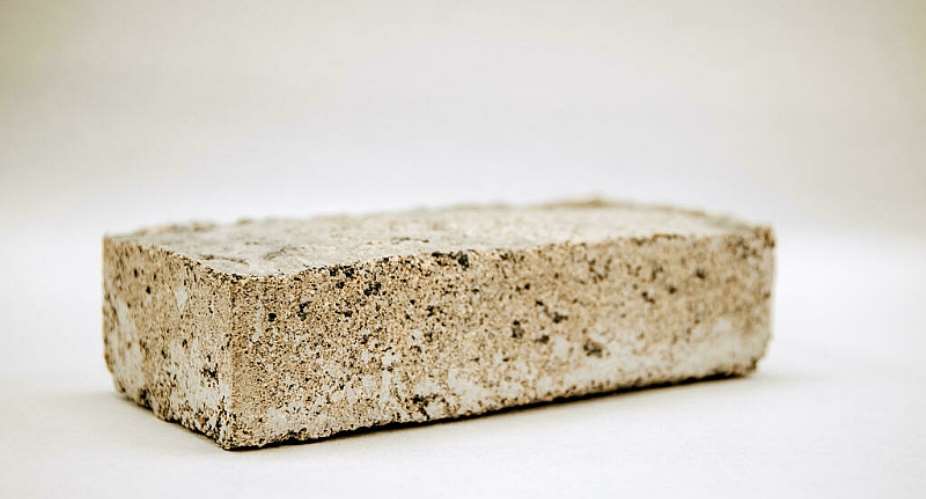A team of scientists in South Africa is making building bricks using human urine. It turns out that, not only do they help recycle otherwise troublesome human waste, the bricks are also stronger than conventional ones. And they don't smell funny.
“Nature knows no waste, and that's where I take inspiration from for much of our work,” said Dyllon Randall, associate professor in water quality engineering at the University of Cape Town.
The chemical engineer and his team, which includes graduate students Vukheta Mukhari and Suzanne Lambert, developed a system in which urine is piped through a mould containing a mixture of sand and gravel.
Urea in the urine reacts with a non-pathogenic bacteria in a process known as microbially-induced calcium carbonate precipitation.
It binds the material together into a solid grey bio-brick, the same way sea shells or coral are formed.
Value from waste
Innovations like this are becoming increasingly important amid calls for modern economies to become more sustainable and reduce their impact on the natural world.
“I think this type of work, that focuses on creating value from various waste streams, is critical for achieving the ambitious climate change agenda,” Randall told RFI.
The production of a single bio-brick uses 18 litres of urine. That's down from 30 litres of urine per brick when the team first unveiled their concept three years ago.
The team made another breakthrough earlier this year in which each bio-brick was strengthened to withstand more pressure than a conventional one made from clay.
Source of fertilizer
All this is achieved at room temperature in the laboratory. It does not have the heavy carbon footprint involved in making bricks the conventional way - which requires baking in wood, gas or coal-fired kilns or ovens.
The bio-brick production process uses just one percent of the urine's components, namely carbonate and calcium ions, Randall explained.
What's left over is used to make liquid and solid fertilizers rich in ammonia, nitrogen, potassium and phosphate.
That's also important. Fertilizer is needed to boost crop production to feed a growing human population.
Yet known global reserves of phosphate rock - a key source of phosphorus used to make fertilizer - are finite and unevenly distributed (Morocco controls around 85 percent).
It's unclear when these reserves will run out, though researchers say it could be within the next 50-100 years.
To further enhance the use of human “waste streams”, Randall and his team recently carried out experiments using mine tailings - material left over after minerals are extracted from ore - as the aggregate inside the brick moulds.
Plastics, building rubble and glass could also be used, he said.
No smell
Randall says after drying, the bio-bricks have no smell and are safe to handle. He said a deeper understanding of the chemical processes involved may be required by a public squeamish about the idea of using products made from human waste.
The team still has to figure out how to produce bio-bricks at scale, though Randall points out that US firm BioMASON has already achieved this.
In 2019 the firm was “growing” 2,500 bio-bricks per day, albeit with synthetic urea.
Randall said he envisages a future, not too distant, where buildings collect and recycle human urine (and other waste streams) for the production of water, fertilizers, energy and even bio-bricks.
He added: “We have shown that we can make several products just from human urine but imagine what we could achieve if we did this with all the waste streams we produce.”





 Togo leader Gnassingbe follows father's political playbook
Togo leader Gnassingbe follows father's political playbook
 NDC panics over Bawumia’s visit to Pope Francis
NDC panics over Bawumia’s visit to Pope Francis
 EC blasts Mahama over “false” claims on recruitment of Returning Officers
EC blasts Mahama over “false” claims on recruitment of Returning Officers
 Lands Minister gives ultimatum to Future Global Resources to revamp Prestea/Bogo...
Lands Minister gives ultimatum to Future Global Resources to revamp Prestea/Bogo...
 Wa Naa appeals to Akufo-Addo to audit state lands in Wa
Wa Naa appeals to Akufo-Addo to audit state lands in Wa
 Prof Opoku-Agyemang misunderstood Bawumia’s ‘driver mate’ analogy – Miracles Abo...
Prof Opoku-Agyemang misunderstood Bawumia’s ‘driver mate’ analogy – Miracles Abo...
 EU confident Ghana will not sign Anti-LGBTQI Bill
EU confident Ghana will not sign Anti-LGBTQI Bill
 Suspend implementation of Planting for Food and Jobs for 2024 - Stakeholders
Suspend implementation of Planting for Food and Jobs for 2024 - Stakeholders
 Tema West Municipal Assembly gets Ghana's First Female Aircraft Marshaller as ne...
Tema West Municipal Assembly gets Ghana's First Female Aircraft Marshaller as ne...
 Dumsor is affecting us double, release timetable – Disability Federation to ECG
Dumsor is affecting us double, release timetable – Disability Federation to ECG
